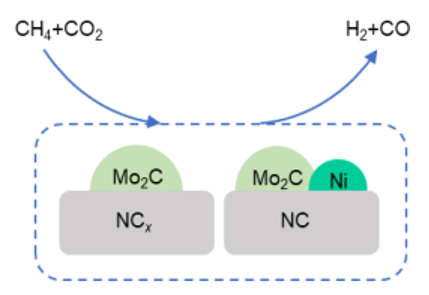
|
基本信息Personal Information
副研究员(自然科学) 硕士生导师
性别 : 男
毕业院校 : 中国科学院大连化学物理研究所
学历 : 博士研究生毕业
学位 : 博士学位
在职信息 : 在岗
所在单位 : 杭州高等研究院
入职时间 : 2019年11月14日
办公地点 : 杭州高等研究院童趣楼101-2
联系方式 : 0571-82257902
Email :
20250501_Ni-Mo2C/NC上甲烷干重整的论文发表于ChemCatChem, 祝贺2022级研究生任梦想!
发布时间 : 2025-05-01 点击量 :
Methane dry reforming on N-doped carbon-supported Mo2C catalysts: Impacts of N functionality and Ni addition
Click here: xx
Abstract
Nitrogen-doped carbon (NC)-supported Mo and Ni-Mo catalysts were synthesized via pyrolysis and impregnation strategies to investigate their performance in methane dry reforming (DRM). By modulating nitrogen content (1.65–13.25 at.%) and speciation (pyridinic/pyrrolic vs. graphitic N) in NC supports, we demonstrated that nitrogen functionalities critically influence MoO2 reduction and Mo2C stabilization. Higher N content in NC2 and NC3 enhanced metal-support interactions, promoting Mo2C formation during H2 reduction, while NC1 (low N) favored metallic Mo. However, under DRM conditions, all catalysts deactivated due to Mo2C oxidation to MoO2, with stability marginally improved at 850 °C via improved "oxidation-re-carbonization" cycles. Introducing Ni (5–15 wt.%) via impregnation facilitated CH4 dissociation and lowered MoO2 reduction temperatures through hydrogen spillover, boosting initial CH4/CO2 conversions and H2/CO ratios. Yet, Ni incorporation accelerated carbon support degradation (>50% mass loss) and induced inactive phases (NiO, Ni3Mo3N), offsetting its promotional effects. Combined XRD, H2-TPR, Raman, and XPS analyses revealed the interplay between N defects, Mo speciation, and Ni-Mo interactions, underscoring the challenges in balancing activity and stability. This study highlights the dual role of nitrogen in stabilizing active phases and the limitations of Ni-Mo bifunctionality under oxidative DRM conditions, providing critical insights for designing robust, carbon-supported catalysts through defect engineering and structural optimization.


